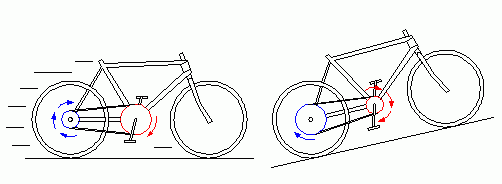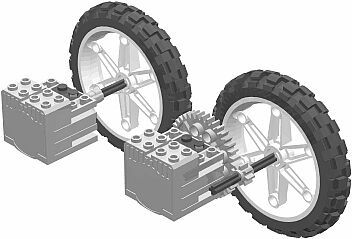Gear Train Assembly (3)
| Now that you have built the geartrain, let's
look at how the gears work in it.
|
|
Start the program on the RCX so the wheels start turning. While they are turning, gently push on the tires one at a time, creating resistance for the motor (don't do this for more than a few seconds each or it could drain the batteries rather quickly). Which wheels where easier to slow down? Why do you think that is? At the beginning of this exercise we looked at how gears affect speed, but there is another factor involved as well: Torque. Consider the gears on a multi-speed bicycle: when going up hill, you use different gears than when coasting or riding on a flat roadway; and your speed is usually different as well.
|

|
You use different gears because you have a limited amount or Power available in your body, and you are using it to move the bicycle. That Power is related to torque this way: Power = Torque x Speed To say this equation in a different way, "if you are limited in Power and you need more Torque, then you have to reduce your speed." Keep this in mind when you build a driving mechanism for your LEGO creations. This picture below shows two ideas that probably won't work very well. They will generally be uncontrollable or too weak to be useful. |

![]()
|
Gears can be used in many different ways. We have only talked about a few types, and there are many others to explore. Here is one application that uses Worms and Worm Gears. |
 |
![]()
| Now download the assignment on geartrains, and return it next class as homework. Do as much in class as you can so you can get help from the instructor if you have difficulty with any part of it. This is an Individual Assignment - one per person. |